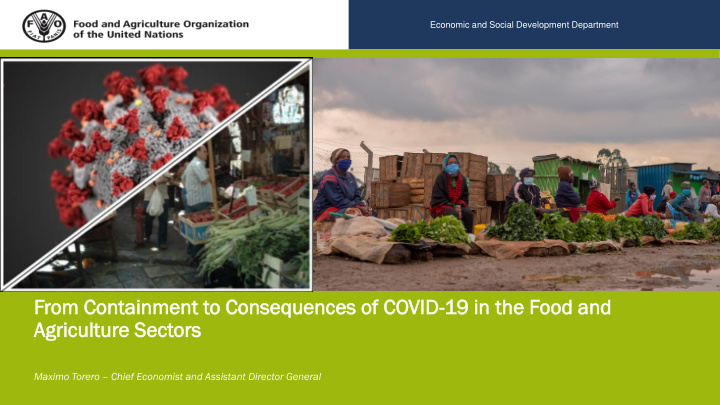



Economic and Social Development Department R e s o u r c e M o b i l i z a t i o n D i v i s i o n From m Contain inme ment t to Conseq equen uence ces s of COVID-19 9 in in the e Food d and d Agr gric iculture ulture Sec ector ors Maximo Torero – Chief Economist and Assistant Director General
R e s o u r c e M o b i l i z a t i o n D i v i s i o n The issue The coronavirus pandemic has been a crushing one-two punch to the global economy, delivering a dual shock to supply and demand in quick succession. It’s a serious threat to food security because even though there is enough food for everyone in the world, it’s not a given that people have access to it. The first jab was the disruption to the global food supply chain. The second blow is a global recession. Surging job losses means that people are losing income to buy food. It could trigger a food crisis induced by lack of income rather than high food price. Inequalities will be exacerbated specially on gender and minorities.
Then Impacts of COVID-19 on GDP Growth World Advanced economies EMDEs 8 4.2 4.6 4 3.9 Percent 0 -2.5 -4 -5.2 -7.0 -8 2010 2011 2012 2013 2014 2015 2016 2017 2018 2019 2020 2021 Source: World Bank. Note: EMDEs = emerging market and developing economies. Shaded area indicates forecasts. Data for 2019 are estimates. Aggregate growth rates calculated using GDP weights at 2010 prices and market exchange rates.
Then Impacts of COVID-19 on Global Extreme Poverty 89-117 million people pushed to extreme poverty in 2020
The Regional Distribution of the COVID-19 Induced Poor
OECD – The recovery will be slow and uncertain World GDP Constant prices, index, 2019Q4 =100 November 2019 projections Single-hit scenario Double-hit scenario 110 105 100 95 90 85 2019 2020 2021 Source: OECD
Highest Valued Exports
Rising undernourishment in net food importing countries
Jobs at risk *Source: FAO/IFPRI unpublished estimates, based on ILO 2020 – ILO extrapolation scenario. Not annualized. Jobs represent formal employment; livelihoods cover a broad array of self-employed, informal, migrant and seasonal labor.
UPDATE with your Division: Business Development and Resource Mobilization R e s o u r c e M o b i l i z a t i o n D i v i s i o n Division What to do? Health-Food- Development Tri- ology
Apple’s mobility data
What to do? Meet immediate needs of vulnerable populations: Emergency Food Assistance, nutrition interventions and safety nets enhanced and made more accessible Promote school Ensure that emergency Protect basic consumption S cale up nutritional S upport management School feeding feeding food needs are fully met needs of vuhierable support and prevention of programs – without populations undernutrition schools Adjust social protection Allow free and predictable Ensure that local purchases Explore the establishment Reach all households with fl ow of food assistance of ef fi cient and ef fective programmes for of food and food components pertinent public information food prices for humanitarian purposes humanitarian food on food assistance, nutrition and are exempt from restrictions reserves hardship alleviation programmes Food Systems Transformation
A healthy diet is unaffordable for the poor in every region of the world a) Cost of an energy sufficient diet compared with the b) Cost of a healthy diet compared with the international international poverty line poverty line NOTES: Maps show the affordability of each of the three reference diets (energy sufficient, nutrient adequate and healthy diet) by comparing the cost of each of them with the international poverty line (USD 1.90 PPP a day) in 159 countries in year 2011, converted to international dollars using purchasing power parity (PPP). Unaffordability occurs here when the cost of a diet is higher than USD 1.33, i.e. 70 percent of USD 1.90 PPP a day, which accounts for a portion of the poverty line that can be credibly reserved for food. SOURCE: Herforth, A., Bai, Y., Venkat, A., Mahrt, K., Ebel, A. & Masters, M. 2020 . Cost and affordability of healthy diets across countries . Background paper for the State of Food Security and Nutrition in the World 2020. FAO, Rome. Unpublished.
What todo? Meet immediate needs of vulnerable populations: Urgent increases in food availability from smallholder farmer food production Promote E-commerce for agriculture Food Systems Transformation
Meet immediate needs of vulnerable populations: Issues on trade and tax policies Adjustments to trade and tax policies Improve ef fi ciency Encourage better functioning Immediately review trade and Avoid generalized subsidies Reduce restrictions on food markets through improved t axat ion policy options for food consumers use of stocks of trade facilitation regional political and economic and their likely impacts integration and better functioning for t radein food Use limited strategic Minimize use of export Reduce import tarif fs and Temporarily reduce grain reserves restrictions other restrictions VAT and other taxes Food Systems Transformation
R e s o u r c e M o b i l i z a t i o n D i v i s i o n What to do? Health-Food- Development Tri- ology
UPDATE with your Division: Business Development and Resource Mobilization R e s o u r c e M o b i l i z a t i o n D i v i s i o n Division Prepare for the future?
After Before
Robotics Automatization
Horizontal farming Vertical farming
E-commerce
THANK YOU Food Systems Transformation
Recommend
More recommend